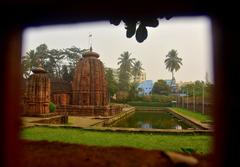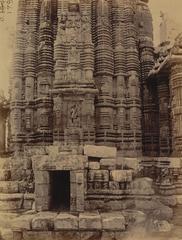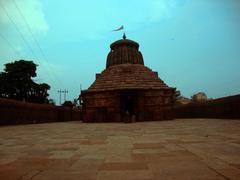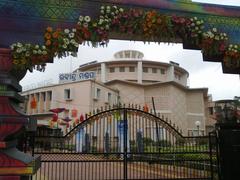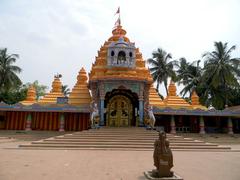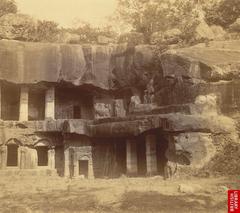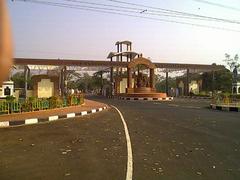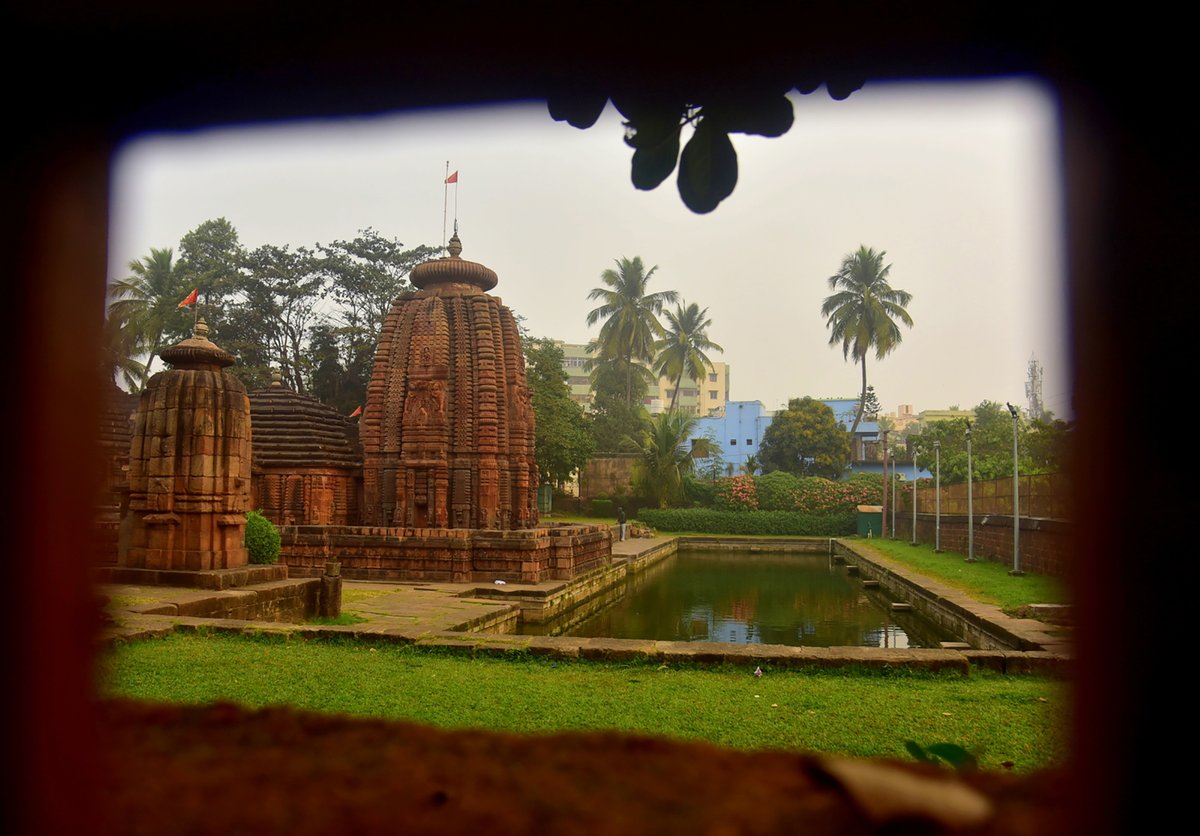
Visiting Mukteswar Temple: Hours, Tickets, and Travel Tips
Date: 18/07/2024
Introduction
Table of Contents
- Introduction
- History and Significance of Mukteswar Temple
- Visitor Information
- Special Events and Festivals
- Guided Tours
- Nearby Attractions
- Frequently Asked Questions (FAQ)
- Conclusion
History and Significance of Mukteswar Temple
A Jewel of the Kalinga School
The Mukteswar Temple, though smaller in size compared to some of its contemporaries, holds a significant position in the architectural timeline of Bhubaneswar. It marks a period of transition and experimentation where the Kalinga style reached its zenith.
- Transitional Style: The temple showcases a move away from simpler designs towards the more elaborate style that would define later temples like the Rajarani Temple and the Lingaraj Temple.
- Architectural Significance: Often referred to as the ‘Gem of Odisha architecture,’ the temple’s intricate carvings and decorative motifs are believed to have served as blueprints for grander temples.
A Celebration of Shaivism
The Mukteswar Temple is dedicated to Lord Shiva, a principal deity in Hinduism. The temple’s iconography and sculptures reflect this dedication, narrating tales from Shiva’s mythology and showcasing various aspects of Shaivism.
- Lord Shiva as the Main Deity: The temple’s sanctum sanctorum houses a Shiva lingam, the abstract representation of Lord Shiva.
- Depictions of Shiva’s Life and Legends: The temple walls are adorned with intricate carvings depicting scenes from Shiva’s life, including his marriage to Parvati, his dance as Nataraja, and his role as the destroyer of evil.
Intricate Carvings and Decorative Motifs
The Mukteswar Temple is renowned for its elaborate carvings, considered some of the finest examples of Kalinga artistry. These carvings cover almost every inch of the temple’s surface, showcasing the skill and dedication of the artisans.
- Floral and Geometric Patterns: The temple walls are adorned with a rich tapestry of floral and geometric patterns, often holding symbolic meaning in Hindu mythology.
- Mythological Figures and Scenes: Interspersed with the decorative motifs are intricate carvings of mythological figures and scenes from Hindu epics like the Ramayana and the Mahabharata.
- Erotic Sculptures: The temple features erotic sculptures, primarily on the lower levels, representing the cycle of life, death, and rebirth, and the importance of procreation in Hindu beliefs.
The Torana – A Gateway to Divinity
One of the most striking features of the Mukteswar Temple is its ornate torana, or arched gateway, serving as a symbolic entrance to the sacred precinct.
- Architectural Marvel: The torana is a masterpiece of Kalinga architecture, with its soaring archway and intricate carvings. It is believed to be a later addition to the temple complex.
- Symbolic Significance: The torana represents the gateway to enlightenment and liberation in Hindu beliefs, symbolizing the transition from the mundane world to a sacred space.
Visitor Information
Mukteswar Temple Visiting Hours
The Mukteswar Temple is open to visitors from 6 AM to 7 PM daily. It is advisable to visit early in the morning or late in the evening to avoid the crowds and experience the temple’s serene atmosphere.
Mukteswar Temple Tickets
There is no entry fee for the Mukteswar Temple, making it accessible to all visitors. However, donations are welcome and contribute to the temple’s maintenance and preservation.
Travel Tips
- Accessibility: The temple is easily accessible by road, and public transportation options like buses and auto-rickshaws are readily available.
- Nearby Attractions: Other historical sites in Bhubaneswar, such as the Lingaraj Temple, Rajarani Temple, and the Odisha State Museum, are worth a visit.
- Photography: The temple is a photographer’s delight with its intricate carvings and scenic surroundings. Be sure to capture the beauty of the torana and the detailed sculptures.
Special Events and Festivals
The Mukteswar Temple hosts several festivals throughout the year, with Shivratri being the most significant. During these festivals, the temple comes alive with rituals, ceremonies, and a large influx of devotees.
Guided Tours
For a more in-depth understanding of the temple’s history and significance, guided tours are available. These tours provide valuable insights and enrich the overall experience.
Nearby Attractions
Bhubaneswar, often referred to as the “Temple City of India,” is home to numerous ancient temples and historical sites. Here are some notable attractions located near Mukteswar Temple:
1. Parsurameswara Temple (c. 7th century CE)
Located just a short walk from Mukteswar Temple, Parsurameswara Temple is one of the oldest and best-preserved temples in Bhubaneswar. Known for its intricate carvings and sculptures, the temple showcases the early architectural style of the Kalinga dynasty.
- Highlights: Exquisite carvings depicting scenes from Hindu mythology, including the epics Ramayana and Mahabharata.
- Distance from Mukteswar Temple: Approximately 200 meters.
2. Lingaraj Temple (c. 11th century CE)
Dedicated to Lord Shiva, Lingaraj Temple is one of the largest and most prominent temples in Bhubaneswar. Its towering spire and vast complex are architectural marvels representing the Kalinga style at its zenith.
- Highlights: The massive Lingam (phallic representation of Shiva), intricate carvings on the temple walls, and the sacred Bindusagar Tank.
- Distance from Mukteswar Temple: Approximately 2 kilometers.
3. Rajarani Temple (c. 11th century CE)
Known for its graceful architecture and intricate carvings, Rajarani Temple is a masterpiece of Kalinga architecture. The temple’s name is derived from the reddish-gold sandstone used in its construction.
- Highlights: The erotic sculptures adorning the temple walls, the beautiful torana (gateway), and the serene ambiance.
- Distance from Mukteswar Temple: Approximately 1.5 kilometers.
4. Brahmeswara Temple (c. 11th century CE)
Dedicated to Lord Shiva, Brahmeswara Temple is renowned for its exquisite carvings and sculptures. The temple’s architecture reflects a transition between the early and later phases of the Kalinga style.
- Highlights: The intricate carvings depicting scenes from Hindu mythology, the impressive shikhara (tower), and the peaceful surroundings.
- Distance from Mukteswar Temple: Approximately 2.5 kilometers.
5. Udayagiri and Khandagiri Caves (2nd century BCE)
Dating back to the 2nd century BCE, the Udayagiri and Khandagiri Caves are a complex of rock-cut chambers and shrines carved into two adjacent hills. These caves served as residential and meditative retreats for Jain monks.
- Highlights: Ancient inscriptions, sculptures of Tirthankaras (Jain spiritual leaders), and panoramic views from the hilltop.
- Distance from Mukteswar Temple: Approximately 6 kilometers.
6. Odisha State Museum (1938)
Established in 1938, the Odisha State Museum houses a rich collection of artifacts and exhibits showcasing the state’s art, history, and culture.
- Highlights: Ancient sculptures, manuscripts, tribal art, and archaeological findings from various periods of Odisha’s history.
- Distance from Mukteswar Temple: Approximately 3 kilometers.
7. Dhauli Giri (Peace Pagoda)
Located on the outskirts of Bhubaneswar, Dhauli Giri is a Buddhist pilgrimage site marking the location where Emperor Ashoka renounced violence after the Kalinga War. The Shanti Stupa (Peace Pagoda) atop the hill offers panoramic views of the surroundings.
- Highlights: The Shanti Stupa, Ashoka’s Rock Edicts, and the serene ambiance.
- Distance from Mukteswar Temple: Approximately 8 kilometers.
8. Ekamra Kanan Botanical Gardens
Spread over a vast area, Ekamra Kanan Botanical Gardens is a tranquil oasis offering a diverse collection of plants, trees, and flowers. It’s an ideal place to relax and enjoy nature.
- Highlights: The medicinal plant garden, rose garden, and the serene lake.
- Distance from Mukteswar Temple: Approximately 4 kilometers.
Frequently Asked Questions (FAQ)
Q: What are the Mukteswar Temple visiting hours? A: The temple is open from 6 AM to 7 PM every day.
Q: Is there an entry fee for Mukteswar Temple? A: No, entry to the temple is free, though donations are welcome.
Q: What is the best time to visit Mukteswar Temple? A: The best time to visit is during the winter months (October to March).
Q: Are there guided tours available at Mukteswar Temple? A: Yes, local guides are available and can provide detailed insights into the temple’s history and architecture.
